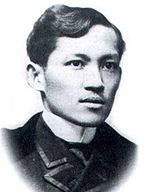- Men in the Philippines
-
 A Filipino man wearing a Barong Tagalog.
A Filipino man wearing a Barong Tagalog.
Men in the Philippines is a term referring to the male members of Filipino society, or men who belong or come from the Philippines, a country in South East Asia or the Far East. This is synonymous to the phrases Filipino men[1] , Philippine men,[2] Filipino males, Philippine males, men from the Philippines, men of the Philippines, and men of Philippine society.
Contents
Role models
 Jose Rizal, the national hero of the Philippines, is a role model of young Filipino men.
Jose Rizal, the national hero of the Philippines, is a role model of young Filipino men.
Based on the national survey presented by Gerardo Sandoval, Mahar Mangahas, and Linda Luz Guerrero at the 14th World Congress of Sociology in Montreal Canada on July 26 to August 1, 1998, Filipino male youth aged 15 to 30, revealed that their male role models are primarily their father (10%) and the Philippine national hero, Jose Rizal (24%) (Filipino female respondents regard their mothers as their female role models).[3]
Participation in society
Despite efforts in the Philippines to advance the status of Philippine women, particularly in relation to occurrences of gender inequality, there was a move in ensuring equal contribution from both men and women in the economic, social, political, cultural, and environmental development of the Philippines. The aim, according to the 2001 to 2004 Framework Plan for Women (FPW) of the Philippine Plan for Gender and Development (PPGD) (which is a thirty-year plan) was to provide both genders "with equal conditions for realizing their full rights" in the country's development, and to improve the "awareness and capabilities" of both genders in participation, making decisions, powers, and control in such a development project.[4]
Population
According to the CIA World Fact Book, which was based on a July 2001 census estimation, there were 15,547,712 Filipino males within the 0–14 years old bracket, 24,374,849 Filipino males within the 15-64 yearls old age range, and 1,355,046 Filipino males belonging to the 65 years and older age group.[5]
Family size
Based on the data gathered by NDHS in 2003, there were 22% of Filipino husbands who prefer having a large family or who wants to have a high number of offspring. This result of the survey were dependent "socio-demographic characteristics" which includes the men's age (plus age at marriage), education, employment status, poverty status, familial characteristics, duration of marriage, the number of living children.[6]
See also
- Filipino people
- Women in the Philippines
- Demographics of the Philippines
- Ethnic groups in the Philippines
- Courtship in the Philippines
- Filipino psychology
- Filipino values
References
- ^ The Filipino Men 72, hubpages.com
- ^ Philippine Men (Filipinos), jacobimages.com
- ^ Sandoval, Gerardo, Mahar Mangahas, and Linda Luz Guerrero. The Situation of Filipino Youth: A National Survey, Social Weather Stations, sws.org.ph
- ^ Statistics on Women and Men in the Philippines, Women and Men in the Philippines, nscb.gov.ph
- ^ Is there a shortage of MEN in the Philippines??, filipinawives.com, asawa.org, 2009
- ^ Pedroso, Luis M. Respondents' Characteristics and Fertility Preference: The Case of Filipino Husbands and Wives, journals.sfu.ca
External links
- Photographs of Filipino men from jacobimages.com
- Advincula, Anthony D. Profile of the New Filipino Family: House-Husbands Watch the Home Front While Women Fill U.S. Demand for Nurses, New America Media, Immigration, September 25, 2009, alternet.org
- The Filipino Male and His Ego, houseonahill.net
- LaHoz, Mila. My Problem, My Husband, A Filipino mother explains why her husband clings to "Filipino macho values, newint.org, July 1980
- Dumanig, Francisco Perlas. Phonological Differences of (f) and (v) Among Young Filipino Male and Female Students, ecampus.inti.edu.my
- Naraval, Camilo A.B. Filipino Masculinity, a documented presented as slides (click on page-down/page-up keys/buttons to change pages or place cursor at middle of page then left-click your computer's mouse), Health and Management Research Group, asienhaus.de
Categories:- Men
- Filipino people
- Philippine culture
- Filipino men
- Asian people
- Southeast Asian people
Wikimedia Foundation. 2010.

